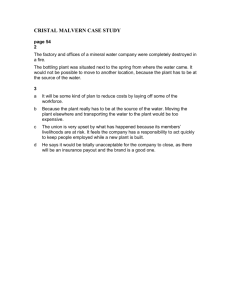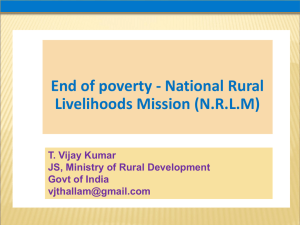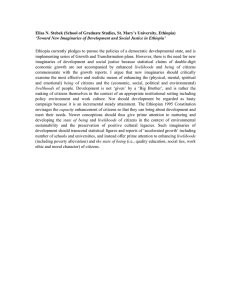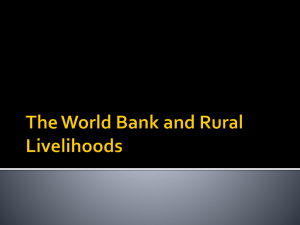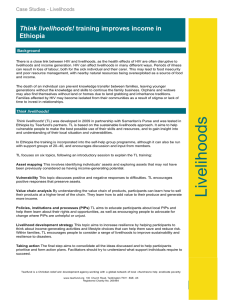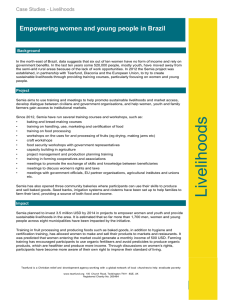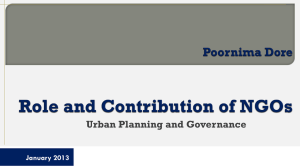Urban Hunger and Livelihoods – Save the Children
advertisement
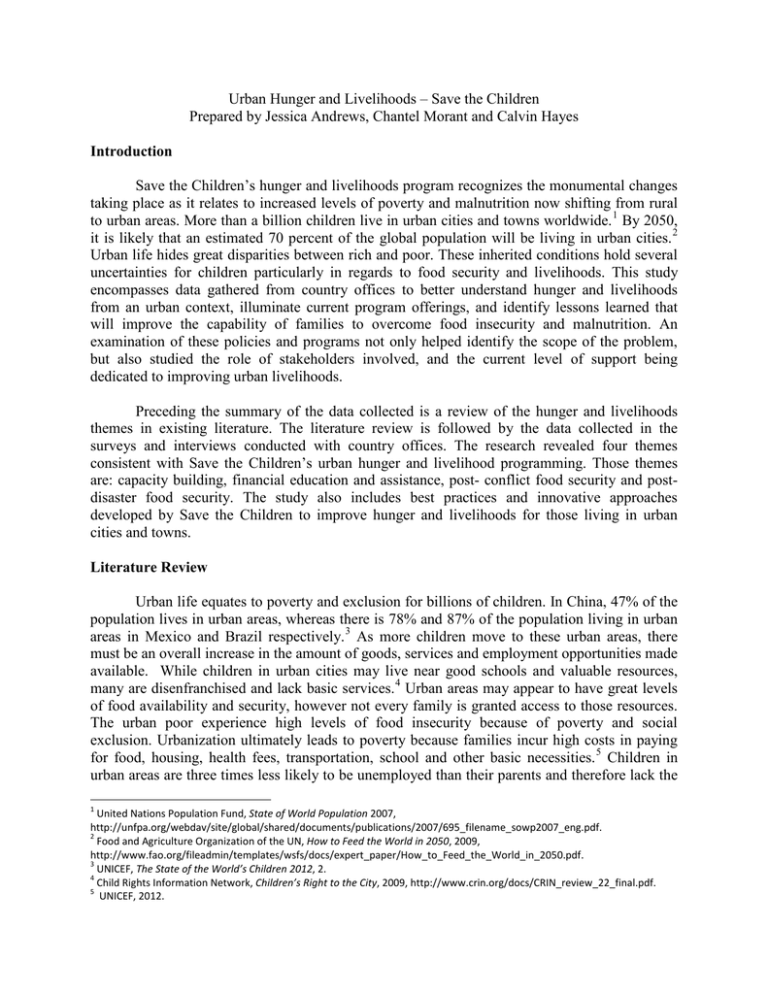
Urban Hunger and Livelihoods – Save the Children Prepared by Jessica Andrews, Chantel Morant and Calvin Hayes Introduction Save the Children’s hunger and livelihoods program recognizes the monumental changes taking place as it relates to increased levels of poverty and malnutrition now shifting from rural to urban areas. More than a billion children live in urban cities and towns worldwide. 1 By 2050, it is likely that an estimated 70 percent of the global population will be living in urban cities. 2 Urban life hides great disparities between rich and poor. These inherited conditions hold several uncertainties for children particularly in regards to food security and livelihoods. This study encompasses data gathered from country offices to better understand hunger and livelihoods from an urban context, illuminate current program offerings, and identify lessons learned that will improve the capability of families to overcome food insecurity and malnutrition. An examination of these policies and programs not only helped identify the scope of the problem, but also studied the role of stakeholders involved, and the current level of support being dedicated to improving urban livelihoods. Preceding the summary of the data collected is a review of the hunger and livelihoods themes in existing literature. The literature review is followed by the data collected in the surveys and interviews conducted with country offices. The research revealed four themes consistent with Save the Children’s urban hunger and livelihood programming. Those themes are: capacity building, financial education and assistance, post- conflict food security and postdisaster food security. The study also includes best practices and innovative approaches developed by Save the Children to improve hunger and livelihoods for those living in urban cities and towns. Literature Review Urban life equates to poverty and exclusion for billions of children. In China, 47% of the population lives in urban areas, whereas there is 78% and 87% of the population living in urban areas in Mexico and Brazil respectively. 3 As more children move to these urban areas, there must be an overall increase in the amount of goods, services and employment opportunities made available. While children in urban cities may live near good schools and valuable resources, many are disenfranchised and lack basic services. 4 Urban areas may appear to have great levels of food availability and security, however not every family is granted access to those resources. The urban poor experience high levels of food insecurity because of poverty and social exclusion. Urbanization ultimately leads to poverty because families incur high costs in paying for food, housing, health fees, transportation, school and other basic necessities. 5 Children in urban areas are three times less likely to be unemployed than their parents and therefore lack the 1 United Nations Population Fund, State of World Population 2007, http://unfpa.org/webdav/site/global/shared/documents/publications/2007/695_filename_sowp2007_eng.pdf. 2 Food and Agriculture Organization of the UN, How to Feed the World in 2050, 2009, http://www.fao.org/fileadmin/templates/wsfs/docs/expert_paper/How_to_Feed_the_World_in_2050.pdf. 3 UNICEF, The State of the World’s Children 2012, 2. 4 Child Rights Information Network, Children’s Right to the City, 2009, http://www.crin.org/docs/CRIN_review_22_final.pdf. 5 UNICEF, 2012. financial ability to purchase food and maintain a nutritious diet. 6 In 2011, more than 74.8 million youth between the ages of 15-24 were unemployed. 7 Urban youth are placed at a disadvantage when competing for jobs because many lack basic skills, education and job training. Additionally, when confronted with environmental disaster or political conflict, children are the most vulnerable population and therefore are the most negatively affected These challenges present an opportunity to redirect rural programming resources to urban areas and to implement more projects that focus on income generating activities and capacity building skills to help with job placement for urban youth. Financial Services and Employment Urban cities have generally been associated with employment and economic opportunities for youth. However, more than half the children living in urban areas are lowincome. 8 Low levels of formal education disqualify many youth from competing for jobs and obtaining the necessary skills to improve their livelihoods. 9 Children that migrate to urban areas are less likely to get a job than those who are urban residents because of educational inequalities and disparities between the urban rich and poor. 10 Throughout forty five different countries, the urban rich are more likely to complete secondary education than their poor counterparts who lack basic primary education. Over 90 percent of the poor urban youth in Cambodia, compared to 82% of the rural poor and 31% of the urban rich lack basic primary education. 11 Poor urban youth in several African countries, such as Kenya and Nigeria, face extreme economic challenges and threats to their livelihood because they must compete with urban residents who have formal education and advanced skills. 12 As a result, many urban youth depend solely on jobs in the informal sector, which may include construction, waste picking, car vending and street repair. 13 Jobs in the informal sector pay substantially less than employment opportunities in the formal sector which require advanced education. Reducing poverty among urban youth is largely dependent upon expanding secondary education opportunities. Additionally, enhancing skills development is an appropriate response to adequately address urban employment problems. Job training would allow urban youth to be more self- reliant and would lead to an increase in professional opportunities. Particularly in West Africa, youth who obtain a secondary education increase their earning potential by more than 20-50% and have greater chances of escaping poverty. 14 6 UNICEF, 2012. UN International Labor Organization, UN System Task Team on the Post-2015 UN Development Agenda: Emerging Development challenges for the post-2015 UN development agenda: Employment, 2012, http://www.un.org/millenniumgoals/pdf/Think%20Pieces/5_employment.pdf. 8 UNICEF, 2012. 9 Caroline Ratcliffe and Signe-Mary McKernan, Child Poverty and Its Lasting Consequence, Urban Institute, 2012, http://www.urban.org/UploadedPDF/412659-Child-Poverty-and-Its-Lasting-Consequence-Paper.pdf. 10 Gina Adams, Kathryn Tout, and Martha Zaslow, Early Care and Education for Children in Low- Income Families Patterns of Use, Quality, and Potential Policy Implications, The Urban Institute and Child Trends, 4 (2007): 1-35. 11 UNESCO, Education for All Global Monitoring Report: Chapter 6 Skills for urban youth – A chance for a better future, 2012, http://www.unesco.org/new/fileadmin/MULTIMEDIA/HQ/ED/pdf/gmr2012-report-ch6.pdf. 12 M.Adato and L.Bassett, Social protection to support vulnerable children and families: the potential of cash transfers to protect education, health and nutrition, AIDS Care: Psychological and Socio-medical Aspects of AIDS/HIV, Routledge, 21:S1 (2011), 60-75, http://www.tandfonline.com/doi/pdf/10.1080/09540120903112351. 13 UNESCO, 2012. 14 UNESCO, 2012. 7 Improving skills among poor urban youth must be facilitated at the national level and implemented as an educational- reform strategy particularly designed to address the urban informal sector. Offering social protection, legal support and training for workers such as street vendors would not only help to increase income, but also upgrade their technical and business skills to run microenterprises. 15 Second chance programs are also critical components for reinforcing basic educational and literacy among poor urban youth to improve employability. In 2009, the government of Liberia partnered with UNICEF to reach more than 75,000 students by providing a second- chance program that offered a direct route to the formal education system, new skills learning, and vocational support to start small businesses. 16 In Nepal, the Alliance for Social Mobilization partnered with the government to offer vocational education and training in car repair, computer- hardware maintenance, construction and cooking. A study indicated that 66% of the youth that participated came from economically marginalized backgrounds and 73% successfully found employment after the program. 17 Strengthening second chance programs empowers poor urban youth with better work opportunities and a greater chance to compete with their well- educated counterparts Microfinance and social protection programs that encourage literacy and numeracy skills are also profitable investments that give young people the foundation to start small businesses, build credit and invest money wisely. Save the Children recently partnered with the MasterCard Foundation to launch Youth Save, a program supported by a $12.5 million that brings together financial institutions, governments, and NGOs to provide savings products to disadvantaged youth, which will enhance their access to better education, skills, and economic opportunities.18 Savings and insurance programs increase youth employment and entrepreneurship because small loans automatically eliminate initial financial constraints and impediments. Currently, 82% of microfinance clients live in Asia, 7% live in Latin America and 2% in Sub- Saharan Africa and the Middle East. Expanding microfinance options and programs across regions is a key element of improving hunger and livelihoods while also offering sustainable support to entrepreneurs among urban youth. 19 Expanding access to apprenticeships and internships is also a key element in developing the capacity to improve livelihoods and alleviate poverty. Apprenticeships and internships in the formal sector are usually awarded through family contacts and networks. As a result, girls and young people with disabilities are usually excluded from selection. 20 Equitable access to apprenticeships and internships is an imperative policy issue that must be addressed to increase skills development and youth employment in poor urban areas. 21 In Ghana, apprenticeships provide 80 - 90% of all skills training including in the fields of motor repair and construction. Internships and apprenticeships in countries like Kenya and Pakistan offer more flexibility, 15 Jacob Levitsky, USAID Microenterprise Stocktaking Evaluation, Small Enterprise Development 1.2 (1990): 51-54. UNICEF, 2012. 17 UNICEF, The State of the World’s Children 2011. 18 Save the Children, What do Youth Savers Want?, 2012, http://mastercardfdn.org/wp-content/uploads/YouthSave-MarketResearch-Report_FINAL1.pdf. 19 UNESCO, 2012. 20 UNESCO, 2012. 21 Linda Winfield, Developing Resilience in Urban Youth, 2004, http://ecap.crc.illinois.edu/eecearchive/books/resguide/winfield.pdf. 16 affordability and immediate practical experience. 22 Developing internships and apprenticeships in urban areas into a dual mechanism that incorporates theoretical learning and practical training, while specifically granting wider access to poor urban youth, is a critical element of achieving improved livelihoods and increasing youth employment. Emergency Food Security and Livelihoods Food security is most commonly referred to as the ability of all people, at all times to consume a healthy and nutritious diet.23 For most urban dwellers, the lack of economic means and ability to purchase foods is the overarching issue. Without claim to any arable land, most of these households rely solely on purchased goods. However, in Nigeria, purchased goods amount to over 60 percent of total expenditures of each household, and families have very little economic means to handle the costs of household goods, transportation, energy, education, healthcare and other items that are essential to survival, which are also usually overpriced.24 When an urban household does not meet basic food needs, the family is deemed food insecure and unable to access a nutritious diet. Food insecurity is at the core of environmental disasters and political unrest. Environmental disasters have the potential to destroy infrastructure and disrupt food distribution and supply.25 Violence often leads to political instability and hinders resource allocation in urban areas. When confronted with environmental and political turmoil, a population must have the capacity to protect itself against damage, loss, or disaster. 26 An Emergency Food Security and Livelihoods program works to prevent acute malnutrition during environmental shock by helping a population meet their most immediate food needs and recovering basic livelihoods. Emergency food security interventions include, but are not limited to, a nutrition analysis and surveillance period, which seeks to access the depth of food insecurity and damage. An assessment is usually followed by basic food distribution and dry- supplementary feeding. As a population gradually recovers from shock and their basic needs are met, an emergency program may implement cash transfer programs, business skills training and an asset protection mechanism. 27 Children are the most vulnerable to injury, death and malnutrition in the face of disaster and environmental shock. Children in urban cities are not exempt from the consequences resulting from drought, severe rainfall, and earthquakes. 28 Due to high population densities in urban cities, 22 UNESCO, 2012. Food and Agriculture Organization of the UN, An Introduction to the Basic Concepts of Food Security, 2008, http://www.fao.org/docrep/013/al936e/al936e00.pdf. 24 Todd Benson, et al., Global Food Crises: Monitoring and Assessing Impact to Inform Policy Responses, International Food Policy Research Institute, 2008, http://www.ifpri.org/sites/default/files/publications/pr19_1.pdf. 25 United Nations Economic and Social Commission for Asia and the Pacific, Policy Issues for the ESCAP Region, 2006, http://www.unescap.org/62/English/E1362e.pdf. 26 Kenneth Marsh and Betty Bugusu, Food Packaging – Roles, Materials, and Environmental Issues, Institute of Food Technologies, 2007, http://ift.org/knowledge-center/read-ift-publications/science-reports/scientific-statussummaries/~/media/Knowledge%20Center/Science%20Reports/Scientific%20Status%20Summaries/FoodPackagingEnviron_04 07.pdf. 27 USAID, FSNAU and FEWSNET, Market functioning in southern Somalia, 2011, http://www.fews.net/docs/Publications/Somalia%20Market%20Functioning%20July%202011.pdf. 28 Viridiana Garcia, Children Malnutrition and Horizontal Inequalities in Sub-Saharan Africa: A Focus on Contrasting Domestic Trajectories, UNDP, 2012, http://web.undp.org/africa/knowledge/WP-2012-019-garcia-working-afhdr-malnutritioninequalities.pdf. 23 disaster leads to a rapid spread of diseases, poor drainage systems and infrastructure, and inadequate disbursement of resources. More than 200,000 refugees from Ethiopia, Somalia, Eritrea and Rwanda have migrated to urban areas in Kenya and are struggling to make ends meet because they have unsuccessfully been able to respond to environmental shock. 29 In 2011, the World Food Program provided food assistance to 7.8 million people in five countries and was able to move nutritional products by sea, air and road to address the most vulnerable throughout the Horn of Africa. 30 Emergency Food Security programs are most effective when populations are least resilient. Two types of resilience that exist are inherent and adaptive. Inherent resilience is the ability of a system to perform under normal circumstances. Adaptive resilience is the ability of a system to perform in crisis situations. In most cases, children living in urban cities are operating within the realm of inherent resistance and the consequences can sometimes be deadly. 31 Parents of poor urban children usually take shelter in the most affordable structures available. As a result, an overwhelming majority of these families live in vulnerable conditions, which consist of overcrowded slums, hazardous –waste sites, and other places that lack the proper protection to guard against extreme disaster. 32 Children in these urban cities most often live in houses that are made from delicate and outdated material that stand little chance of surviving an earthquake or other environmental disaster. 33 An Emergency Food Security programs would direct efforts toward asset replacement and basic repair of shelter. Agriculture and Value Chains Agriculture development and food production is drastically changing in rural areas but has little impact on urban areas. Instead, a sustainable food production mechanism would be useful in urban areas to strengthen the opportunity for poor people to gain access to a local food supply. 34Sustainable food production is an engagement of practices that keep the environment healthy and conducive for food production. Programs of this type are urgently needed in urban areas because of the rise in global environmental degradation, competition for resources, increased population sizes, a greater need for food, and the contribution of agriculture to the international economy. 35 A sustainable food production program includes environmental accounting, carrying capacity, equity, and product supply and food security. These perspectives identify the biophysical limits of agriculture and the maximum population level that the 29 Josh Chaffin, Young and Restless: Harnessing the Economic Resilience of Displaced Youth in Nairobi, Women's Refugee Commission (2012). 30 World Food Programme, Ethiopia: Annual Report, 2011, https://www.wfp.org/sites/default/files/WFP%20Ann.%20Report_0.pdf. 31 Kathleen Tierney and Michel Bruneau, Conceptualizing and Measuring Resilience, TR News, 2007, http://onlinepubs.trb.org/onlinepubs/trnews/trnews250_p14-17.pdf. 32 UNICEF, 2012. 33 UNICEF, 2012. 34 Sustainable Development Solutions Network, Opportunities and Solutions for Sustainable Food Production, 2013, http://unsdsn.org/files/2013/01/Agriculture-Paper-for-HLP.pdf. 35 Food and Agriculture Organization of the UN, Towards the Future We Want, 2012, http://www.fao.org/docrep/015/an894e/an894e00.pdf. agriculture can serve in urban cities. 36 Agriculture value chains are also focused on the use of natural resources. Natural resources and their overall contribution to rural livelihoods have been deeply explored, but have not been fully investigated within an urban context. However, urban based natural resources are a significant field of study because it provides an innovative approach to improving and supporting urban hunger and livelihoods. Natural resources have been traditionally limited to land for the purposes of agriculture and water to support sanitation and irrigation. 37 Exploring natural resource efficiency in urban cities allows the opportunity to think about these areas more broadly to include biological- resource themes like trees, plants, and waste. Additionally, greater use of non- biological resources like rocks and minerals can be explored to make the greatest use of resource efficiency in urban areas. 38 Natural resources in urban cities can be used for the production of cereal- crop cultivation, vegetable and mushroom production, and cattle. Consuming natural resources allows food to be eaten without having to make a purchase, trees to be burned for wood, and rocks to build houses. These untraditional resources can also promote trade and employment because land, rocks, and vegetables can be sold to stimulate the economy. 39 Land in urban cities is scarce, but can be used to grow agricultural products to produce vegetables, furniture and wood. Using water wisely in urban cities is far more than just for the purposes of cleaning, cooking and drinking, but can also contribute to the process of brewing beverages and producing soap to be sold. 40 Finally, waste as a natural resource can be used for the recycling of raw material and the scavenging for food in urban cities. For example, storm brewing is taking drain waste and transforming them into shitake mushrooms to feed animals. 41 Resource efficiency involves transforming waste and other untraditional natural resources into opportunities as a strategy to improve hunger and livelihoods. Urban Governance Urban governance is a critical component of improving hunger and livelihoods for children in urban settings. Urban governance is a system that allows civil society to exercise political participation, directly settle disputes, and equip the urban poor with the tools to demand essential services and resources. 42 36 Sustainable Development Solutions Network, SDSN Factsheet, 2013, http://unsdsn.org/files/2013/03/SDSN_factsheet_US.pdf. 37 UNIDO and UNEP, Taking Stock and Moving Forward, 2010, http://www.unido.org/fileadmin/user_media/Services/Environmental_Management/Contacts/Contacts/Taking%20stock%20an d%20moving%20forward-November2010.pdf. 38 Rachel Slater and Chasca Twyman, Hidden Livelihoods? Natural Resource-Dependent, Livelihoods and Urban Development Policy, Overseas Development Institute, 2003, http://www.odi.org.uk/sites/odi.org.uk/files/odi-assets/publications-opinionfiles/2462.pdf. 39 FAO, 2009. 40 UNIDO and UNEP, 2010. 41 Food and Agriculture Organization of the UN, Global Food Losses and Food Waste, 2011, http://www.fao.org/fileadmin/user_upload/suistainability/pdf/Global_Food_Losses_and_Food_Waste.pdf. 42 UNHABITAT, Good Urban Governance: Towards an Effective Private Sector Engagement, 2009, http://www.unhabitat.org/downloads/docs/WG_B_Background_Urban_Governance&the_PrivateSector_draft0.pdf. Urban Governance has been defined as: The exercise of political, economic and administrative authority in a management of a country’s affairs at all levels in an urban setting. It includes mechanism of formal and informal processes implemented by the state, which allow citizens and groups to articulate their concerns and exercise their political rights. 43 Good urban governance is a critical element to eliminating poverty, social exclusion and hunger. Creating a mechanism and a conducive environment for the poor to express their concerns is inextricably bound to the capability of securing sustainable livelihoods. 44 Influencing urban policy is directly connected to the ability of citizens to advocate for better policies dealing with water, housing, health and infrastructure. Improving urban governance also focuses on providing programs and policies that will create jobs and opportunities for the urban poor to be self- reliant. 45 Additionally, improving urban governance can identify new ways to eliminate discriminatory practices. Urban youth are discriminated against based on gender and disabilities when competing for educational and employment opportunities. Urban children with disabilities are particularly vulnerable to poverty and discrimination because they are not taken seriously and have less access to file grievances. In West Africa, more than 50 percent of children who are deaf and 60 percent who are intellectually impaired are discriminated against in the workplace and in everyday life. In Senegal, disabled children in urban areas are sometimes required to pay additional fees for healthcare costs. 46 Urban governance and policy offers a platform to address these issues and a mechanism for youth to improve their hunger and livelihoods situation. 47 Children living in these cities are most affected by urban policies and regulations. Increasing income, reducing risk against environmental shock, and implementing new regulatory policies for natural resource management are essential elements of strengthening urban governance and improving hunger and livelihoods. 43 UNHABITAT, 2009. UNICEF, Children’s Rights and Good Urban Governance, 2003, http://www.childfriendlycities.org/pdf/conference_february_report.pdf. 45 UNICEF, 2012. 46 CRIN, 2009. 47 Women in Informal Employment Globalizing and Organizing, Supporting Urban Livelihoods, Reducing Urban Poverty, 2010, http://wiego.org/sites/wiego.org/files/resources/files/Chen_Supporting_Urban_Livelihoods.pdf. 44 Mapping and Analysis of Existing Save the Children Hunger and Livelihoods Programs Country Project Name Zimbabwe Cash for Work/Smart Card Program Partner Organizations • • TN Bank USAIF Office of Foreign Direct Investment • KIVA Sub- Thematic Area • • • Vietnam VietnamCan Tho City Thanh Hoa Fund for Poor Women Golden Hand Microfinance Program • Financial Education and Assistance Cash Transfers Financial Education and Assistance • Microenterprise • Financial Education and Assistance • Microfinance • Agriculture and Value Chains Population Served • • • Project Value $225,000 Poor urban families in Karoi, Hurungwe, Kariba, Binga and Hwange districts Poor urban women Women entrepreneurs Loan Portfolio $1.5m • Women age 18- 50 Loan Portfolio: $252,000 • Microentrepreneurs and farmers $350,000 KIVA Training on Agriculture Techniques • • Chevron CitiBank Vietnam Vocational Training • USAID • Employment • Households with disabilities N/A Philippines Cash Assistance and Skills Training • KRAFT • Emergency Food Security Assistance • Poor Urban Women N/A Philippines Jobs and Skills Training • Accenture • Employment • At- risk children living in urban areas N/A Vietnam Country Project Name Sri Lanka Cash Assistance Program • American Red Cross China Skills to Succeed Program- Job training and skills • Kyrgyzstan Food Distribution Program • Bangladesh Education and Vocational Training Azerbaijan Care and Maintenance of Refugees & Asylum Seekers in Azerbaijan Burkina Faso Cambodia BFA Emergency Nutrition and Livelihoods Assistance for Drought Affected Families Food Security program Partner Organizations Sub- Thematic Area Population Served Project Value • Emergency Food Security and Livelihoods • TsunamiAffected Households in the Eastern Province of SriLanka N/A Accenture • Employment • Migrant youth in Shanghai and Beijing. N/A • Emergency Food Security and Livelihoods • Families displaced by inter-ethnic conflict N/A • World Food Program USAID • European Union • Employment • Child and Youth Laborers N/A • • UNHCR Azerbaijan Financial assistance Refugee and asylum-seeking families N/A • • CIDA • Emergency food security • Families affected by flooding in Kaya and Barsalogho Health Districts N/A • • EJAF Global Fund • Food Security • Orphans and vulnerable children affected by AIDS N/A Country Project Name Partner Organizations Sub- Thematic Area Population Served Project Value Haiti Emergency food security • • • DEC KPMG SIDA • Emergency food security • Families affected by the earthquake in Port au Prince and other areas N/A Haiti Agriculture • SIDA • Agriculture and value chains • Farms near urban areas affected by earthquake N/A Haiti Financial services • DEC • Financial assistance • Families affected by the earthquake N/A • Families in Blantyre N/A Malawi Care and Savings • • • • Emergency Food Security and Livelihoods • Humanitarian food aid Malawi government USAID UKAID WFP Miller family of USA • Malawi • Financial education and assistance • Households with children under the age of 2 in Blantyre N/A Malawi Cash transfers • • WFP UAID • Financial assistance • Vulnerable families in Blantyre N/A Thailand Emergency food security • • • • • • • SC UK SC Sweden ECHO SONY Hewlett Packard SC US US corporates • Emergency food security • Families affected by flooding in Bangkok N/A Capacity Building Job training/Placement Program Capacity building is an integral aspect of development programs particularly in urban settings. The rapid growth of urbanization in many emerging nations has increased the demand for sustainable programs that enhance the skill set of constituents while ensuring the overall functionality of the organizations that serve them. In the case of Save the Children’s urban programs, job training and placement was a common element country offices used to build capacity. In Bangladesh for example, SC partnered with the European Union (EU) to develop demand-driven, flexible and efficient Technical and Vocational Education and Training (TVET) that led to employment and income opportunities for participants. Of the 5000 young people that participated in TVET, each of them have increased income, job training and placement. This result is significant because it was targeted toward young people who worked in the informal economy whose jobs included, forced labor and prostitution. Save the Children’s Bangladesh office, also trained more than a dozen child laborers within the Education for Youth Empowerment program (EYE). In partnership with the EU, Ikea, Comic Relief and other organizations, EYE launched a 6-12 month vocational and skills training initiative, which concluded by placing participants in entrepreneurship and wage employment positions. EYE enabled child laborers to get out of hazardous work conditions and get basic education to better prepare them for their future. In an effort similar to SC Bangladesh, China’s hunger and livelihood program focuses on migrant youth in urban dwellings with Shanghai and Beijing. Its main objectives are to: 1. Improve the quality of vocational education including career development and support services offered and its relevance to the local labor market of 10,000 youth in Shanghai and Beijing 2. Empower 10,000 migrant youth to build their personal strengthen and confidence by providing them with essential social and business skills. 3. Create an enabling environment for migrant youths in Shanghai and Beijing by building a multi sector, support network and advocating for positive policy changes toward young migrant workers. Among other examples of capacity building and job training and placement best practices are in Vietnam. As part of the hunger and livelihood program, SC Vietnam partnered with Chevron and CitiBank to create a micro finance program which helped entrepreneurs and farmers receive training in a variety of agriculture techniques. The training included animal husbandry as well as homes gardening. More than 400 micro-finance clients received training. Following the program, 72% of the participants reported having applied the knowledge they gained to their agricultural production and business which led to an increase in productivity and profits. Financial Education and Assistance Cash for Work/Smart Card Program Save the Children improves hunger and livelihoods in urban areas by focusing on innovative ways to increase access to financial services through cash transfers. Targeted cash transfers can affect the world’s poorest children. A lack of income among poor households is the leading cause of malnutrition in urban areas. Children in urban areas are more likely to be healthier if their families have greater access to financial resources and the necessary support to purchase or grow food. Save the Children hunger and livelihoods programs focuses on improving the financial potential of poor urban families through income generating activities like cash transfers and the savings and lending’s program. Cash transfers not only help to increase access to food availability, but also help families purchase clothes, seed fertilizers, health services and education resources. Cash transfers bring together public and private partnerships that will provide income to the poor and protect the most vulnerable populations. The two types of cash transfers are unconditional and conditional. An unconditional transfer is cash provided by the government or non- government organization to a household that has been identified to be highly vulnerable and economically marginalized for the purpose of alleviating poverty. A conditional transfer usually requires a work- requirement, loans that require repayment, cash for subsidized food fertilizer or education and health fee waivers. The evidence gathered from Save the Children country offices indicate that many of the cash transfer programs implemented gave participants greater access to financial services to repair declining livelihoods resulting from environmental and economic shock. For example, in 2008, Zimbabwe suffered a humanitarian crisis which included political instability, land problems, drought and a decrease in agriculture production and exports. Consequently, household food security began to deteriorate because of an increase in food prices and a decrease in employment options and money- generating activities. In 2010, Save the Children responded with a Cash for Work (CFW) program to increase the purchasing power of poor urban families. Through a partnership with TN Bank and the USAID Office of Foreign Direct Assistance, Save the Children was able to introduce the first ever technology based cash delivery system, which reached the Karoi, Hurungwe, Kariba, Binga and Hwange districts of Zimbabwe. SC staff issued a smart card to each household, which was connected to a personal bank account. Using a Point of Sale system, participants could buy goods, services, and withdraw cash. There were nearly 1000 participants that received $25 per month in each district to purchase basic goods and services. Beneficiaries were also encouraged to participate in a Savings and Lending’s Program, which provided training on financial literacy, household budgeting and savings strategies. As a trade- off, one member from each family worked on a public works project 12 days per month focused on improving sanitation and hygiene practices in their respective communities. Save the Children found that the programs lead to greater levels of food security for each district. For example, in Karoi, 69 % of families were obtaining 100% of their food security needs as oppose to the 29% before the implementation of cash transfers. The average household income increased from $82 to as high as $134 over the course of the project. Microenterprise Project- Thanh Hoa Fund for Poor Women In Vietnam, many women in urban areas lack the financial means and resources to support their children. In response, Save the Children offered several microfinance programs, which provided small loans to women. The programs collectively served more than 10,000 participants and allocated more than $500,000 to help improve livelihoods and economic security for poor women in urban areas. For example, Save the Children partnered with Thanh Hoa Fund for Poor Women to provide and improve access to financial and non- financial services such as loans, savings, insurance and training to women urban entrepreneurs. Thanh Hoa is one of the poorest provinces for women in Vietnam and lack of loan capital is the greatest challenge for many of them. The fund is licensed by the Vietnamese government, operates in 7 districts, maintains a loan portfolio of USD 1.5m and benefits more than 10,650 borrowers. Golden Hand Microfinance Program Save the Children also established the Golden Hand Microfinance Program in Can Tho City through a joint partnership with Tho Women’s Union and Chevron. The program was purposed to improve the income capacity of women microentrepreneurs by introducing them to locally adapted livelihood practices that would increase their profits and improve access to financial services. The program served more than 1,463 women within the age of 18-50 and gave participants the financial flexibility to engage in other income generating activities like starting small businesses. The program not only allows participants to generate income but also improves livelihoods by increasing knowledge of budgeting through a financial education training course. Post-Conflict Food Security Local Regional Procurement Project In times of conflict and disaster, women and children are typically most at risk of suffering the harsh consequences that follow such tragedies. Conflict situations are particularly traumatic for these vulnerable groups because they often devastate economies and agricultural production which in many cases leads to food insecurity. In the case of Kyrgyzstan, the country office along with the United States Agency for International Development and the World Food Program provided emergency food assistance to vulnerable groups in response to the food crisis caused by the country’s interethnic conflict. In 2009 and 2010, the Local Regional Procurement project (LRP) distributed food to Uzbek and Kyrgyz. Although there was greater need in rural areas due to the conflict and drought which hindered agricultural production, SC Kyrgyzstan supplied food items such as oil and flour, to individuals and families throughout the country. At the conclusion of the program, a food-to-work initiative was instituted to provide sustainable assistance to those in need. Despite the success of the program, SC Kyrgyzstan, felt that it could have a greater impact if its food relief program was partnered with others. In addition, the office would like to see more food-to-work initiatives developed in urban areas. Post-Disaster Food Security Disaster Relief Programs In the wake of a natural disaster, food security can instantly become a major problem. Three countries reported extensive disaster-relief programs within Food Security and Livelihoods: Sri Lanka, the Philippines and Haiti. In Sri Lanka in 2007, Save the Children, with additional funding from Red Cross, provided livelihood assistance post-tsunami for the poorest affected households in both urban and rural areas. They were given cash transfers for at least three months, and up to 24 months, to help with food and basic supplies. They targeted the poorest 10% of households, which included 4700 individuals. Urban are decidedly worse-off in Sri Lanka, where there are over 1500 slum and shanty settlements, with over 66,000 housing units. Poverty, violence, crime, drug trafficking and flooding areal problems in these areas. 33% of slum dwellers have limited access to water. 39% have limited access to sanitation. There is a high rate of malnutrition in children and many adults also do not receive enough nutritional value either because they work nine to ten hours a day of hard labor. Urban poor also have to buy more food than rural poor. And when disaster hits, rural poor still have the land they have inherited, whereas urban poor are often left with nothing to generate income. The Philippines has two separate post-disaster food security programs that were in response to flooding and a typhoon. ECHO was implemented in Bulacan and Cagayan De Oro City to provide immediate cash to families to address their immediate food and basic needs. AusAID, through Save the Children Australia, also provided support to families after flooding and had three main objectives: • Increase the capacity of children and youth to identify risks and solutions and initiate action. • Increase the capacity of households to adopt appropriate waste management and alternative livelihood options to ensure food security during disasters. • Establish a system for well-coordinated disaster risk reduction and response actions from stakeholders at the local and provincial levels. After providing start-up money to help people get back on their feet immediately after the disaster, Save the Children Philippines began to focus on building up lost capital. The Philippines has been working in urban areas since 1989, longer than many other countries. They’ve found that it’s more difficult to convince people to participate in programs in urban settings. It’s harder to get people to trust and more difficult to gather people together in urban areas. In Haiti, post-disaster food security obviously became very important in 2010 after the earthquake. The programs worked to improve livelihoods of vulnerable households affected in Port au Prince and other areas. There were over 13,000 beneficiaries in cash for work programs. 450 small traders, 84 artisans and 48 beach restaurant owners received cash grants to restock and rebuild. Many of these were women and all were required to participate in Business Development Services training. 750 households received two rounds of vouchers for fresh food. About 150 households in camps received vouchers for household asset replacement. In 2011, Save the Children distributed cash or vouchers to 7042 individuals for asset replacement. More fresh food was also brought into various camps, particularly for pregnant mothers. Quotes from the surveys: “As urban contexts are different to those of rural, we need to explore and develop diversified livelihoods to reduce the economic barrier, and thus the level of hunger.” (Bangladesh) “In Sri Lanka there are nearly 1506 slum and shanty settlements; mostly illegally constructed on state lands with 66,021 housing units, which are popularly known as low-income settlements and are suffering from a combination of different dimensions of deprivations. For urban development to be truly sustainable, the livelihoods of the urban poor must also be secure. This is a difficult task for them owing to the high degree of exposure to short and long term external risks arising out of both the above mentioned factors and poor peoples’ low capacity to protect themselves from these risks due to inadequate assets. Compared to rural people, these slum dwellers are facing more problems in food security, health care and child protection that require the assistance of Save the Children.” (Sri Lanka) “This is a new area for SC so we need to be positioning ourselves in country with global expertise to show that we are a key player in this area. Currently, there are other INGOs who are doing urban programming (Joint Initiative lead by Mercy Corps), so we’re not perceived as an urban implementer. The dynamics of doing this programming is different from our usual rural work so there would also need to be a shift in our own perceptions of our programming.” (Zimbabwe) “For programs to grow in urban areas, courage is needed. What urban settings lack is convergence. There are many overlapping services, programs and NGOs. The work needs to be mainstreamed, so everyone can look at the big picture. SC’s value is in doing just that and bringing everyone together within the community.” (the Philippines) Experience in each area, by country Employment Azerbaijan Bangladesh Burkina Faso Cambodia China Haiti Kyrgyzstan Malawi Philippines Sri Lanka Thailand Vietnam Zimbabwe Financial education and assistance • Agriculture and value chains Emergency food security • • • • • • • • • • • • • • • • • • Conclusion With more than half of the world’s children living in urban areas, policy leaders and practitioners must develop innovative programs to reduce poverty, build sustainable pathways to increase income, and identify mechanisms to improve access to nutritious food. Save the Children is playing an integral role in positioning programming efforts to assist the most vulnerable populations residing in urban areas. A total of 42 surveys were sent out to country offices and 23 were returned. Only 13 surveys provided usable data for analysis. A longer time frame for data collection would allow for further analysis and more recommendations. Country offices revealed that their current efforts are focused on building income through cash transfers, financial education, and microfinance programs. Several countries are also developing sustainable mechanisms to increase employment through job and skills training. There is also a focus on improving access to nutritious food in the face of environmental disaster through cultivating better farming techniques and promoting capacity building skills. Country offices also indicated that programs in urban areas could be duplicated in rural settings. Therefore, identifying and implementing programs that are uniquely urban is essential to resource allocation and project implementation. Country offices have the opportunity to be more intentional and deliberate about directing efforts and attention to projects that are exclusively urban. Urban programming must take into account participant socio-economic background, culture, limitations and environmental factors. Literature vs. Country Mapping Areas of Focus Existing literature and survey research indicate that Save the Children should be focusing more on financial education and assistance. Programs like the smart card initiative in Zimbabwe and the cash transfer project in Vietnam have shown the greatest results in generating income among the urban poor. Although the literature review reveals themes that focus on strengthening the agriculture sector, in reality these approaches are not appropriate for an urban context. The lack of arable land in urban areas is Number of Save Country Offices with Experience in Each Thematic Area an inherent limitation for families to grow Emergency food security and produce food. The study reveals Financial education and assistance that urban Employment dwellers need Agriculture and value chains more than just 0 1 2 3 4 5 6 7 8 food supply, but also need microfinance projects that will give them loans to start small businesses and training programs to invest their money. Therefore, the area of focus that needs the most attention is financial education and assistance. The best practices presented in this report are proven models of the projects that should continue in urban settings. The country feedback is consistent with these recommendations and program officers have pointed to the most success with projects focused on financial education and assistance and job training. Country Office Recommendations: Collaboration and Strategic Communication Country offices suggested that Save the Children could have a greater impact by increasing coordination with governments, corporations, and other NGOs that may be operating in the same space. Zimbabwe indicated that there are many organizations performing great work in urban areas, however, a lack of coordination and communication prevents collaboration and partnership. Program officers in Zimbabwe recommends that Save the Children take a leading role in developing a strategic communication plan for synchronizing all programs dedicated to improving hunger and livelihoods throughout Zimbabwe and other urban areas within Africa. Cultural Context Vietnam country officers suggested that in order to serve urban populations most effectively, practitioners must be willing to re- examine current urban programming efforts to make sure that those initiatives are appropriate for each cultural context. Urban programs are not universal across all regions and a cultural assessment of each country must be developed before implementing any program. Understanding culture is a key factor in creating programs and initiatives that will be successful in urban areas. Identifying innovative ways to communicate with the targeted audience is critical to understanding their needs, concerns and values. Communication Technologies The recommendations gathered also show a trend toward introducing new information communication technology systems to promote the exchange of information between development organizations and local communities. Increasing the use of mobile phones and internet kiosks could potentially lead to greater developments in education, employment, banking, and entrepreneurship. The key findings, recommendations, and best practices highlighted in this report are critical to strengthening Save the Children’s urban hunger and livelihoods program. Bibliography Adams, Gina, Kathryn Tout, and Martha Zaslow. Early Care and Education for Children in Low- Income Families Patterns of Use, Quality, and Potential Policy Implications, The Urban Institute and Child Trends, 4 (2007). Adato, M. and L.Bassett. Social protection to support vulnerable children and families: the potential of cash transfers to protect education, health and nutrition, AIDS Care: Psychological and Sociomedical Aspects of AIDS/HIV. Routledge, 21:S1(2011), 60-75. http://www.tandfonline.com/doi/pdf/10.1080/09540120903112351. Benson, Todd, et al. Global Food Crises: Monitoring and Assessing Impact to Inform Policy Responses, International Food Policy Research Institute. 2008. http://www.ifpri.org/sites/default/files/publications/pr19_1.pdf. Chaffin, Josh. Young and Restless: Harnessing the Economic Resilience of Displaced Youth in Nairobi, Women's Refugee Commission. (2012). Child Rights Information Network. Children’s Right to the City. 2009. http://www.crin.org/docs/CRIN_review_22_final.pdf. Food and Agriculture Organization of the UN. An Introduction to the Basic Concepts of Food Security. 2008. http://www.fao.org/docrep/013/al936e/al936e00.pdf. Food and Agriculture Organization of the UN. How to Feed the World in 2050. 2009. http://www.fao.org/fileadmin/templates/wsfs/docs/expert_paper/How_to_Feed_the_World_i n_2050.pdf. Food and Agriculture Organization of the UN. Global Food Losses and Food Waste. 2011. http://www.fao.org/fileadmin/user_upload/suistainability/pdf/Global_Food_Losses_and_Food_ Waste.pdf. Food and Agriculture Organization of the UN. Towards the Future We Want. 2012. http://www.fao.org/docrep/015/an894e/an894e00.pdf. Garcia, Viridiana. Children Malnutrition and Horizontal Inequalities in Sub-Saharan Africa: A Focus on Contrasting Domestic Trajectories, UNDP. 2012. http://web.undp.org/africa/knowledge/WP2012-019-garcia-working-afhdr-malnutrition-inequalities.pdf. Levitsky , Jacob. USAID Microenterprise Stocktaking Evaluation, Small Enterprise Development 1.2 (1990). Marsh, Kenneth and Betty Bugusu. Food Packaging – Roles, Materials, and Environmental Issues, Institute of Food Technologies. 2007. http://ift.org/knowledge-center/read-iftpublications/science-reports/scientific-statussummaries/~/media/Knowledge%20Center/Science%20Reports/Scientific%20Status%20Summa ries/FoodPackagingEnviron_0407.pdf. Ratcliffe, Caroline and Signe-Mary McKernan. Child Poverty and Its Lasting Consequence, Urban Institute. 2012. http://www.urban.org/UploadedPDF/412659-Child-Poverty-and-Its-LastingConsequence-Paper.pdf. Save the Children. What do Youth Savers Want? 2012. http://mastercardfdn.org/wpcontent/uploads/YouthSave-Market-Research-Report_FINAL1.pdf. Slater, Rachel and Chasca Twyman. Hidden Livelihoods? Natural Resource-Dependent, Livelihoods and Urban Development Policy, Overseas Development Institute. 2003. http://www.odi.org.uk/sites/odi.org.uk/files/odi-assets/publications-opinion-files/2462.pdf. Sustainable Development Solutions Network. Opportunities and Solutions for Sustainable Food Production. 2013. http://unsdsn.org/files/2013/01/Agriculture-Paper-for-HLP.pdf. Sustainable Development Solutions Network. SDSN Factsheet. 2013. http://unsdsn.org/files/2013/03/SDSN_factsheet_US.pdf. Tierney, Kathleen and Michel Bruneau. Conceptualizing and Measuring Resilience, TR News. 2007. http://onlinepubs.trb.org/onlinepubs/trnews/trnews250_p14-17.pdf. UN International Labor Organization. UN System Task Team on the Post-2015 UN Development Agenda: Emerging Development challenges for the post-2015 UN development agenda: Employment. 2012. http://www.un.org/millenniumgoals/pdf/Think%20Pieces/5_employment.pdf. USAID, FSNAU and FEWSNET. Market functioning in southern Somalia. 2011. http://www.fews.net/docs/Publications/Somalia%20Market%20Functioning%20July%202011.p df. UNESCO. Education for All Global Monitoring Report: Chapter 6 Skills for urban youth – A chance for a better future. 2012. http://www.unesco.org/new/fileadmin/MULTIMEDIA/HQ/ED/pdf/gmr2012report-ch6.pdf. UNHABITAT. Good Urban Governance: Towards an Effective Private Sector Engagement. 2009. http://www.unhabitat.org/downloads/docs/WG_B_Background_Urban_Governance&the_Priva teSector_draft0.pdf. UNICEF. Children’s Rights and Good Urban Governance. 2003. http://www.childfriendlycities.org/pdf/conference_february_report.pdf. UNICEF. The State of the World’s Children. 2012. UNICEF. The State of the World’s Children. 2011. UNIDO and UNEP. Taking Stock and Moving Forward. 2010. http://www.unido.org/fileadmin/user_media/Services/Environmental_Management/Contacts/ Contacts/Taking%20stock%20and%20moving%20forward-November2010.pdf. United Nations Population Fund. State of World Population. 2007, http://unfpa.org/webdav/site/global/shared/documents/publications/2007/695_filename_sow p2007_eng.pdf. United Nations Economic and Social Commission for Asia and the Pacific. Policy Issues for the ESCAP Region. 2006. http://www.unescap.org/62/English/E1362e.pdf. Winfield, Linda. Developing Resilience in Urban Youth. 2004. http://ecap.crc.illinois.edu/eecearchive/books/resguide/winfield.pdf. World Food Programme. Ethiopia: Annual Report. 2011. https://www.wfp.org/sites/default/files/WFP%20Ann.%20Report_0.pdf. Women in Informal Employment Globalizing and Organizing. Supporting Urban Livelihoods, Reducing Urban Poverty. 2010. http://wiego.org/sites/wiego.org/files/resources/files/Chen_Supporting_Urban_Livelihoods.pdf.

